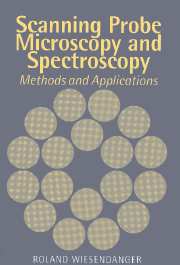Book contents
- Frontmatter
- Contents
- Preface
- List of acronyms
- Introduction
- Part one Experimental methods and theoretical background of scanning probe microscopy and spectroscopy
- Part two Applications of scanning probe microscopy and spectroscopy
- 4 Condensed matter physics
- 5 Chemistry
- 6 Organic material
- 7 Metrology and standards
- 8 Nanotechnology
- References
- Index
7 - Metrology and standards
Published online by Cambridge University Press: 05 October 2010
- Frontmatter
- Contents
- Preface
- List of acronyms
- Introduction
- Part one Experimental methods and theoretical background of scanning probe microscopy and spectroscopy
- Part two Applications of scanning probe microscopy and spectroscopy
- 4 Condensed matter physics
- 5 Chemistry
- 6 Organic material
- 7 Metrology and standards
- 8 Nanotechnology
- References
- Index
Summary
Nanometrology
Nanometrology is defined as the science of measuring the dimensions of objects or object features to uncertainties of lnm or less. The demand for nanometrology comes together with advances in integrated circuit technology where uncertainty requirements, e.g. in mask alignment, will soon approach the length scale lnm (Teague, 1992). The achievement of atomic-resolution real-space imaging of single-crystal surfaces by SPM has opened up novel opportunities in the field of nanometrology.
The highly-ordered atomic lattice of a single-crystal surface can serve as a reference against which the position and motion of an object can be measured and controlled. This idea has triggered the development of a dual tunnel-unit STM (Fig. 7.1), where one tunnel unit is used to provide a crystal reference for the second unit (Kawakatsu and Higuchi, 1990; Kawakatsu et al., 1991). To obtain a reference lattice over technologically relevant areas, there is a strong need for single-crystal surfaces being atomically flat over extended surface regions without the presence of steps or dislocations.
Piezoelectric crystals have proved to allow highly accurate and repeatable motion down to a subatomic length scale. This is clearly demonstrated by SPM images showing regular two-dimensional crystal lattices with measured corrugation amplitudes below 0.1 Å.
However, several problems have to be solved before successful application of SPM in nanometrology can be achieved.
Tip instabilities associated with switching of either the vertical or lateral position of the tip with respect to the substrate must be eliminated by preparation of highly stable tips with reliable long-term performance.
[…]
- Type
- Chapter
- Information
- Scanning Probe Microscopy and SpectroscopyMethods and Applications, pp. 537 - 541Publisher: Cambridge University PressPrint publication year: 1994

